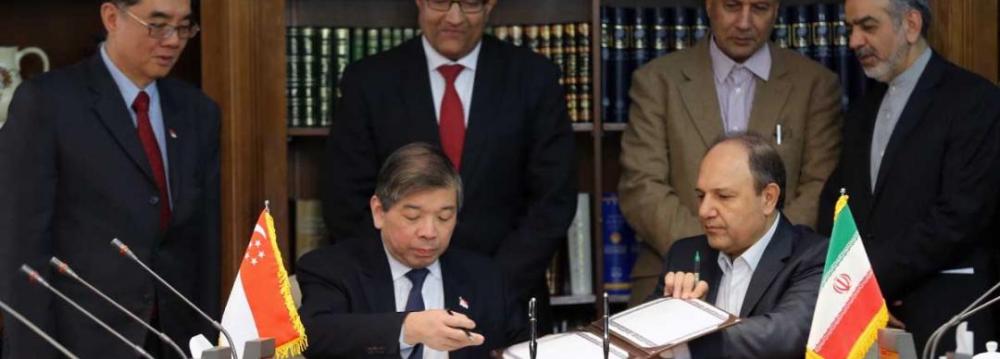Iran’s contract-signing spree gained steam, as Islamic Republic of Iran Shipping Lines and Singaporean trade minister signed a memorandum of understanding on shipping cooperation in Tehran on Sunday.
The MoU was signed in a meeting between Singapore’s Minister for Trade and Industry S. Iswaran and Iran’s Minister of Cooperatives, Labor and Social Welfare Ali Rabiei.
Iran’s shipping revenues will increase by connecting dry bulk and container line IRISL to East Asian shipping lines, state-owned IRNA quoted IRISL chief executive, Mohammad Saeedi, as saying in the meeting.
“The agreement, besides expanding trade and transportation relations between the two countries, will help IRISL to connect East Asia to West Africa,” he said.
IRISL—once a global shipping power—was severely hit by prolonged sanctions imposed over Iran’s nuclear program.
The lifting of sanctions in mid-January as part of a July deal reached between Tehran and the world powers has paved the way for IRISL’s resurgence and cooperation with international companies.
IRISL aims to cash in on Iran’s strategic geographical position and thrive as a global maritime transit hub.
“We had earlier signed shipping agreements with German and other European companies and this MoU will be another link to complete the chain,” Saeedi said.
He had earlier said IRISL is initially planning to connect Persian Gulf ports to Latin American countries and extend its shipping lines to East Asia.
Ports in Central and North America come next in the company’s future plans.
Oman Targets Shipping Ties
It’s not just Singapore that is developing shipping ties with Iran. Oman also aims to expand shipping and trade links with Iran to get ahead of rivals after the lifting of international sanctions, Reuters reported, citing leading port officials involved.
The UAE previously enjoyed greater shipping activity with Iran, but Oman’s nearby Sohar Port is looking at taking a share of that business.
While Oman has maintained warm ties with Tehran, it now faces competition from India, across the Arabian Sea.
Andre Toet, chief executive of Sohar’s port and free zone, acknowledged they were smaller than nearby terminals.
“What we are trying to do is see if we can get a piece of the cake and divert or create new business opportunities for business between Oman and Iran using Sohar as the base for that,” he said.
“The first sign is that it is happening. It is still in very small pockets.”
Sohar, a 50-50 joint venture between the government of Oman and the Dutch port of Rotterdam, acts as the port authority and runs its 45-kilometer free zone.
Toet said Sohar was targeting more trade with major Iranian IRISL and national tanker operator NITC. An IRISL ship made its first call to Sohar recently.
Separately, a direct service between Iran’s major cargo port of Bandar Abbas and Sohar had opened up.
Toet said the port was looking at links with other Iranian terminals such as Chabahar.
“We are talking to several Iranian companies looking for possible investment in the free zone-small metal manufacturing and warehousing distribution of agricultural products,” he said.
Total vessel calls to Sohar reached 2,545 last year—a rise of 26% from the previous year.
With global cargo and container shipping markets suffering a prolonged recession since 2008, Iran represents a potential area of growth for the Oman International Container Terminal, located in Sohar.
“I can see high potential for an increase of trade between our two countries,” said Albert Pang, chief executive of OICT, which is operated by investors, including Hutchison Port Holdings and Oman’s government.
Last year, OICT reported cargo volumes of around 540,000 TEUs versus 329,000 TEUs in 2014, and Pang said it was targeting double-digit growth this year, with Iran potentially adding to it.


